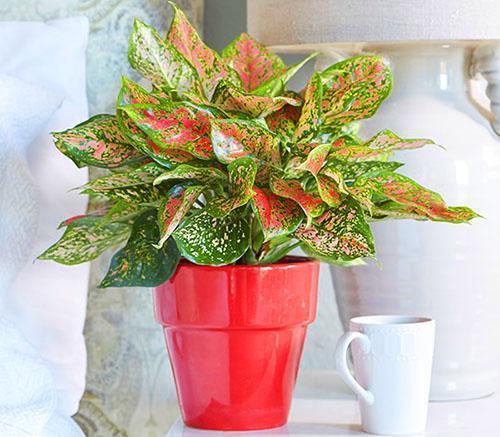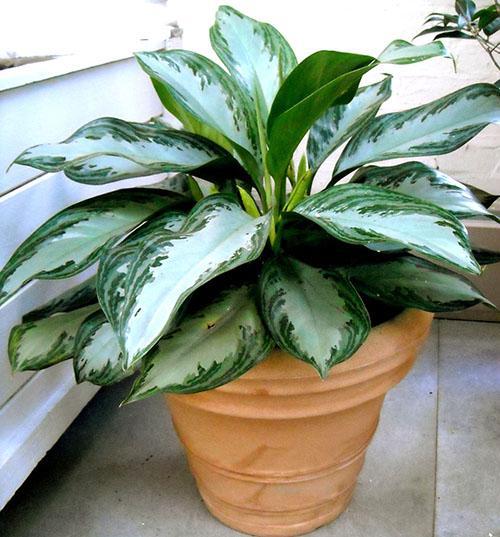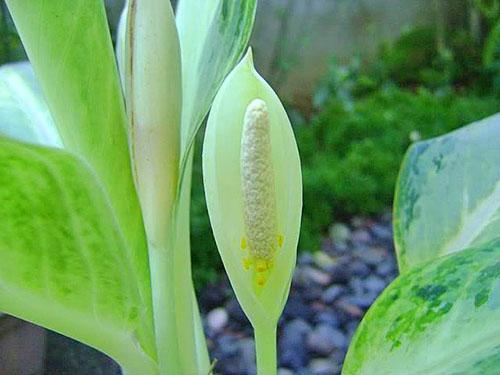Growing a plant from the tropics aglaonema on a window sill
 Growing in the tropical regions of southeast Asia, aglaonems are evergreens that are both very unpretentious and attractive. The species discovered and described at the end of the 19th century were exported to Europe, where aglaonema plants began to be successfully grown in greenhouse conditions.
Growing in the tropical regions of southeast Asia, aglaonems are evergreens that are both very unpretentious and attractive. The species discovered and described at the end of the 19th century were exported to Europe, where aglaonema plants began to be successfully grown in greenhouse conditions.
By this time, many different exotic plants were domesticated by Europeans, striking the imagination with their bright flowering or unusual appearance. The wealth of tropical flora has invariably aroused the interest of botanists and florists, but what attracted them to Aglaonema?
Aglaonema plant: room culture description

 If a catchy inflorescence anthurium became the reason for the appearance of this plant in the collections of indoor crop lovers, the flowering of aglaonema is sometimes even difficult to notice. At the top or in the axils, peduncles also develop, crowned with medium-sized inflorescences with a white or cream cob and a light or greenish veil.
If a catchy inflorescence anthurium became the reason for the appearance of this plant in the collections of indoor crop lovers, the flowering of aglaonema is sometimes even difficult to notice. At the top or in the axils, peduncles also develop, crowned with medium-sized inflorescences with a white or cream cob and a light or greenish veil.
After flowering aglaonema, small juicy orange or scarlet berries are formed in place of the cob, containing cream or brownish, oval seeds.
In nature, the reproduction of aglaonema takes place through root shoots or seeds, and at home, vegetative methods for obtaining new specimens are often used.
 Even at home, aglaonema blooms often and willingly, which distinguishes this culture from a closely related species - Dieffenbachia. It is this plant that resembles aglaonema the most. But this impression is deceptive and develops only with a superficial acquaintance with the culture.
Even at home, aglaonema blooms often and willingly, which distinguishes this culture from a closely related species - Dieffenbachia. It is this plant that resembles aglaonema the most. But this impression is deceptive and develops only with a superficial acquaintance with the culture.
The main advantage of culture is bright, combining all shades from deep green to carmine foliage. It makes the aglaonema plant a bright decoration of any windowsill, and maintaining its external attractiveness does not require special knowledge and efforts.
Conditions for the Aglaonema plant
 Aglaonema, as a resident of the tropics, prefers to stay in a warm room. If in summer the air temperature can vary from 21 to 26 ° C, then in winter, when growth is slightly inhibited, the plant is kept at 18–20 ° C.
Aglaonema, as a resident of the tropics, prefers to stay in a warm room. If in summer the air temperature can vary from 21 to 26 ° C, then in winter, when growth is slightly inhibited, the plant is kept at 18–20 ° C.
It is important that the air does not cool below 12-15 ° C at any time of the year, since such temperatures can negatively affect the condition of the plant.
Especially dangerous:
- draft and flow of cold coming from windows or balconies;
- hot dry air from heating appliances.
Aglaonema's love for warmth also worries breeders. Therefore, when obtaining modern varieties and hybrids, special attention is paid to the ability of the plant to tolerate low temperatures.An example of such a variety is the Silver Queen - Aglaonema plants with silvery-green foliage, which have earned the Royal Horticultural Society award for decorativeness and endurance.
In winter and summer aglaoneme a long day of light is required, at least 11-15 hours. Forcing a green pet to grow with a lack of light can cause it to be overstretched, while:
- internodes are lengthened;
- foliage becomes smaller and loses its decorative effect;
- Aglaonema plants absorb moisture more slowly and mineral supplements.
Although aglaonema is shade-tolerant, variegated plants need diffused light to maintain the brightness and color quality of their leaves. In summer, at noon, pots with aglaonema are shaded to protect from direct rays, and in winter, if necessary, provide artificial lighting.
Watering of plants is changed depending on the season, air temperature and plant condition. In warm weather, the soil should be moistened more abundantly than in winter or late autumn. If the room is cool, then the amount of water is also reduced. At the same time, one should not be guided by the widespread, but erroneous opinion about the unconditional love of moisture for all people from the tropics. Aglaonema will tolerate dry soil more easily than constant waterlogging.
 For irrigation, it is necessary to take only settled warm water. And the substrate in a pot with aglaonema between waterings must be allowed to dry to a depth of 2–4 cm. Aglaonema is good at irrigation with water and washing the foliage with warm water. This procedure helps:
For irrigation, it is necessary to take only settled warm water. And the substrate in a pot with aglaonema between waterings must be allowed to dry to a depth of 2–4 cm. Aglaonema is good at irrigation with water and washing the foliage with warm water. This procedure helps:
- restore the attractiveness of foliage by cleaning it from dust;
- protect the plant from insect pests;
- ensure breathing of the aglaonema;
- increase air humidity.
Do not forget that aglaonema requires regular feeding during the growing season. They are carried out from early spring to October, using compositions for decorative deciduous crops.
Aglaonema transplant
 The peculiarity of the aglaonema plant is that young specimens grow rather quickly, and then growth slows down. Therefore, at first, the florist will have to transplant aglaonema annually. And an adult specimen is usually transferred into a larger pot no more often than two or three years later.
The peculiarity of the aglaonema plant is that young specimens grow rather quickly, and then growth slows down. Therefore, at first, the florist will have to transplant aglaonema annually. And an adult specimen is usually transferred into a larger pot no more often than two or three years later.
The procedure is best carried out at the beginning of spring, carefully transferring the plant along with the soil to a new pot. In parallel with the transplantation of an adult plant, the division of the bush is often carried out - one of the most popular and simple ways of reproduction of aglaonema.
Of all the aroids, Aglaonema is probably one of the most unpretentious crops. In this case, there are no special requirements for the soil for transplanting the aglaonema. The main thing is that the substrate for filling the pot is light, structured, it easily allows air and moisture to pass through, but does not retain excessive amounts of water.
If the density of the substrate is high, it will negatively affect the development of the root system, weaken it and, possibly, provoke the development of fungal or bacterial root rot.
As a soil for transplanting aglaonema, take a mixture:
- 2 parts of sod land;
- 1 part of humus;
- 1 part peat;
- 1 part perlite.
When you cannot mix the components yourself, you can use ready-made substrates for orchids and ornamental crops. They are mixed in equal proportions, adding a little crushed charcoal.
 A pot for aglaonema, plants with a superficial root system, it is more correct to choose not too bulky. The larger the container for the plant, the longer the roots will braid the lump of the substrate, which will delay the development and flowering of the aglaonema.
A pot for aglaonema, plants with a superficial root system, it is more correct to choose not too bulky. The larger the container for the plant, the longer the roots will braid the lump of the substrate, which will delay the development and flowering of the aglaonema.
When choosing a pot for aglaonema, they must take into account the need to create a powerful drainage layer, but a deep container is still not needed.
Reproduction of aglaonema
 At home, you can get young aglaonema plants by dividing an adult specimen using cuttings obtained from the stem, as well as seeds.Vegetative methods, as a rule, are less laborious and allow you to quickly acquire a viable independent plant.
At home, you can get young aglaonema plants by dividing an adult specimen using cuttings obtained from the stem, as well as seeds.Vegetative methods, as a rule, are less laborious and allow you to quickly acquire a viable independent plant.
In addition to the fact that as a result of such reproduction of aglaonema, the daughter specimens fully inherit the parental traits, they are already adapted to the created conditions and more easily tolerate acclimatization.
When growing aglaonema from seeds, there is a risk of seeing seedlings on their own windowsill with foliage that is radically different from the parent.
During growth, some plant species lose their compactness in 3-4 years, become excessively elongated and require renewal. In this case, it is convenient to use the stem for grafting.
 Cuttings are cut from a healthy plant so that there are a couple of nodes on the stem segment. The apical cutting is also used to propagate aglaonema. All planting material on the sections is treated with crushed charcoal, then dried during the day and rooted in water or a substrate consisting of a mixture of equal shares of perlite and peat.
Cuttings are cut from a healthy plant so that there are a couple of nodes on the stem segment. The apical cutting is also used to propagate aglaonema. All planting material on the sections is treated with crushed charcoal, then dried during the day and rooted in water or a substrate consisting of a mixture of equal shares of perlite and peat.
For the rapid formation of the root system and in order to avoid decay of the planting material, cuttings should be kept at a temperature of 22 to 26 ° C and constant humidity.
If all the conditions for the reproduction of aglaonema are met, roots sufficient for planting are formed in 20-30 days. Aglaonema can be transplanted into ordinary soil for adult plants, not forgetting about drainage and careful attitude to still weak roots.
When transplanting an aglaonema, if the plant has grown strongly and gave lateral shoots, it can be divided into several independent divisions. In order not to harm the root system, the procedure is carried out by first watering the soil well. After removing the pot, the aglaonema is cleaned of substrate residues, the roots are taken apart and the daughter layers are separated with a sharp knife.
It is important that all new plants have their own roots and growth point. It is imperative to sprinkle the cut sites with charcoal or activated carbon powder.
 Aglaonema is planted in the same soil as when transplanting. Before planting, the soil is moistened, and for the period of acclimatization, the plants are allowed to stay in humid warm air. Rooting ends when new bright leaves appear on the bush.
Aglaonema is planted in the same soil as when transplanting. Before planting, the soil is moistened, and for the period of acclimatization, the plants are allowed to stay in humid warm air. Rooting ends when new bright leaves appear on the bush.
Aglaonema seeds, which even ripen on domestic plants, can also produce seedlings and young specimens. True, this method will require enviable patience and hard work from the grower.
Since all aroid seeds lose their germination quickly, it is best to use fresh seed from ripe red berries. The washed seeds are embedded in moist sphagnum to a depth of 1–1.5 cm, where they should be kept at a temperature of 20–26 ° C. A decrease in temperature with this method of reproduction of aglaonema directly affects the quality and speed of germination. We must not forget about maintaining high humidity in a homemade greenhouse.
If the seeds of aglaonema are fresh, the sprouts can be expected in 20–25 days, otherwise the process takes up to 3 months. After the formation of a rosette with a diameter of 5-7 cm, the aglaonema dive several times, transferring from a smaller pot to a larger one, and using a substrate of peat, universal soil and perlite. Small pieces of steamed bark and charcoal can be added to the soil for transplanting aglaonema.